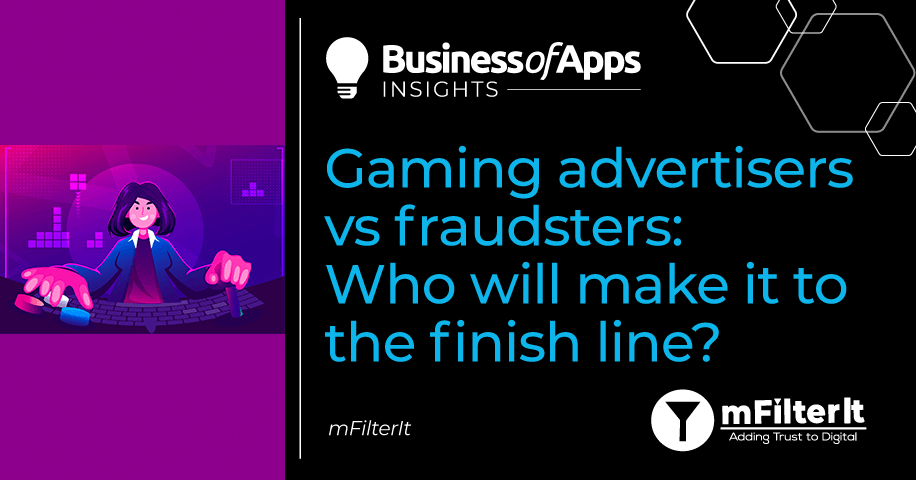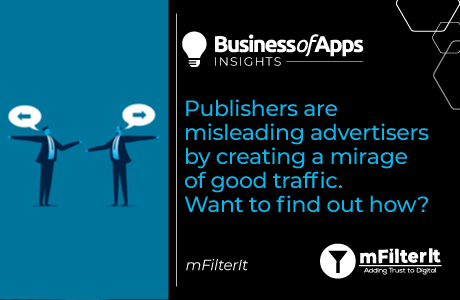You developed a game and now you’re willing to go to the next level. To bring new visitors, you decide to invest a huge amount in advertising your game. You get new users and finally, all efforts make sense. However, something doesn’t feel right. Your installs are high, but the conversions are low.
Shady users are interacting with your game and your genuine users are leaving. The question is, “Why did this happen?” Your digital ads are under attack by fraudsters. You are unaware of their intentions, and they are just hiding behind the screen to counter your next move.
The above scenario is one of the basic cases that a game advertiser has to face. In the pandemic era when the whole world was inside their home, mobile games gave them a chance to escape. In the past 2 years, the number of gamers has increased to 420 million online gamers and approximately 400 gaming companies have come into existence during this phase.
One of the reasons for this growth is high disposable income and an increase in the number of smartphones and tablets. With this sudden spike in gamers, advertisement spend in gaming industries has also increased. In 2021, advertising spend was estimated at $46.7 billion and is expected to increase up to $130.9 million by 2025 worldwide.
This post was first published on mfilterit.com.
It is said that “wherever the money flows, the fraudster’s radar follows it.” And seeing the rapid increase in the gaming industry, the fraudsters are going to sit ideal.
In this blog, we are giving an insight into the various ways fraudsters attack digital ads and steal digital ad spend in the gaming industry.
Games that fraudsters love to play
Steal the credentials (Account takeover)
Account takeover attacks leave a deep impact on the brand and the consumer’s trust. In this type of fraud attack, the fraudsters obtain personal information like the username, password, or email address to illegally log in to a victim’s account.
As the gaming industry continues to grow, ATO attacks have become quite common in this arena. Once the fraudster gets access to the user’s account, they can attempt multiple malicious activities for their profit. Posing as a real customer, the fraudster can get easy access to the account details, withdraw the coins or unique loyalty benefits, make an online purchase, or leverage the stolen account data to hack other accounts of the user on different platforms.
Guess who I am? (Fake accounts)
In the gaming industry, it is expensive to acquire new customers and even costlier to convince a customer to make their first in-app purchase. Thus, the gaming brand needs to ensure that the purchases are legitimate. If not, the brand will bear huge losses from the chargebacks.
The most vulnerable mobile apps are the ones that allow the player to play for free but have features like in-app purchases. In the case of these apps, the fraudster creates a new account and uses stolen credit cards to purchase digital items, go to the next level, or load the account with gaming currency. Once they have made the account a golden asset, they sell it on a trading site.
Ultimate App Growth Guide 2025
Boost your app’s success with the Ultimate App Growth Guide! 🚀 Expert insights, proven strategies & must-know tips. Download now!
Master app growthWhen the credit card owner calls the bank on account of fraudulent charges, the gaming brand ends up paying for the chargebacks. Not just the gaming brand loses its money, but its brand reputation is also at stake.
Win, win, or lose? (Referrals and promo abuse)
Referrals and promotions are run by gaming marketers to engage new customers and retain existing ones. However, when the fraudsters seep into the sales funnel, they use different fraudulent techniques to abuse referrals and promos. Cybercriminals either misuse the promo codes or abuse referral programs by becoming both the referrer and the referee.
When cybercriminals abuse the referral programs and the end customer becomes the victim, they lose trust in the brand. They feel that they have been cheated by the gaming brand. And in this chaos, the fraudster wins, and the advertiser loses both money and consumer trust.
Tippity tap (Click fraud)
Beyond hacking user accounts and stealing referral benefits, the easiest way for fraudsters to extract money is through click fraud. Gaming advertisers invest huge budgets to bring new gamers to their platforms. However, these digital ads are under the constant radar of fraudsters, and they find different ways to steal the advertiser’s money.
When a user installs a malicious app on their phone, the fraudsters get access to the user’s device and can track their activity. Furthermore, when a user downloads the advertiser’s gaming app, the fraudster fires a fake click in the background. This fake click is attributed as the last click source by the MMPs and the fraudsters get the credit for an organic install. Due to this, advertisers end up wasting their ad spend on installs generated by fraudsters.
What do you need to protect your gaming app?
The smarter the advertisers get; the fraudsters ensure to stay one step ahead. They use advanced and sophisticated methods to hide their tracks and keep the advertisers in the dark. To tackle these attacks, advertisers need a solution that can detect the anomalies in an ad campaign and take real-time action to prevent the consequences.
mFilterIt’s ad traffic validation suite helps you eliminate fraudulent traffic using AI, ML, and data science. To reduce the impact of fake users and click spamming, we run various algorithms checks and blacklist the fraudulent IPs and traffic coming from bots or concentrated devices.
Kill the fraudsters, reach your target
It’s time that you must have the right weapon to attack the fraudsters. To ensure it is not a game over for you, keep a real-time check on the fraudster’s movement. This will help you to prevent the consequences of fraudulent activities and save your ad spend from being wasted. And the biggest outcome will be that you will be able to reach the right audience instead of the bot traffic.












